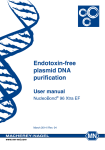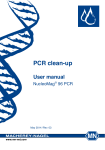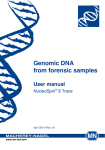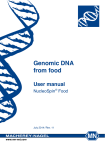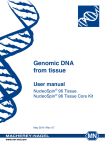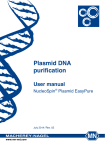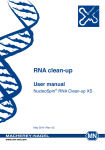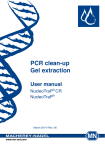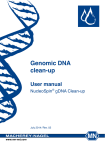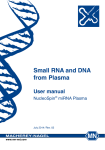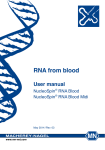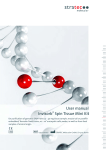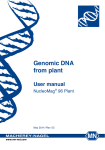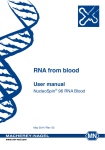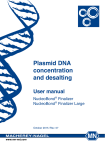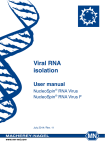Download NucleoSpin® Blood - MACHEREY
Transcript
Genomic DNA from blood User manual NucleoSpin® Blood June 2014 / Rev. 14 Genomic DNA from blood Protocol-at-a-glance (Rev. 14) 1 Lyse blood samples 2 Adjust DNA binding conditions Mini Midi Maxi Mini NucleoSpin® Blood NucleoSpin® Blood L NucleoSpin® Blood XL NucleoSpin® Blood QuickPure 200 μL blood 25 μL Pro.K 200 μL B3 2 mL blood 150 μL Pro.K 2 mL BQ1 10 mL blood 500 μL Pro.K 10 mL BQ1 200 μL blood 25 μL Pro.K 200 μL BQ1 Mix Mix Mix Mix 70 °C, 10–15 min 56 °C, 10–15 min 56 °C, 10–15 min 70 °C, 10–15 min 210 μL ethanol 2 mL ethanol 10 mL ethanol 200 μL ethanol 3 Bind DNA Load all Load 3 mL Load 15 mL Load all 11,000 x g, 1 min 4,500 x g, 3 min 4,000 x g, 3 min 11,000 x g, 1 min Load 3 mL of residue Load 15 mL of residue 4,500 x g, 5 min 4,000 x g, 3 min 500 μL BW 2 mL BQ2 7.5 mL BQ2 600 μL B5 2 mL BQ2 7.5 mL BQ2 ______ 4 Wash silica membrane 1st wash 11,000 x g, 1 min 4,500 x g, 2 min 4,000 x g, 2 min 2nd wash 11,000 x g, 1 min 4,500 x g, 10 min 4,000 x g, 10 min 5 Dry silica membrane 6 Elute highly pure DNA 11,000 x g, 1 min Drying is performed during centrifugation of the last washing step ______ 350 μL BQ2 11,000 x g, 3 min ______ Drying is performed during centrifugation of the last washing step Drying is performed during centrifugation of the last washing step 50 μL BE (70 °C) 100 μL BE, (70 °C) 200 μL BE (70 °C), 500 μL– 2000 μL BE (70 °C) RT, 1 min RT, 2 min RT, 2 min RT, 1 min 11,000 x g 1 min 4,500 x g, 2 min 4,000 x g, 2 min 11,000 x g, 1 min MACHEREY-NAGEL GmbH & Co. KG · Neumann-Neander-Str. 6–8 · 52355 Düren · Germany Tel.: +49 24 21 969-270 · Fax: +49 24 21 969-199 · [email protected] · www.mn-net.com Genomic DNA from blood Table of contents 1 Components 4 1.1 Kit contents 4 1.2 Reagents, consumables, and equipment to be supplied by user 8 1.3 About this user manual 8 2 Product description 9 2.1 The basic principle 9 2.2 Kit specifications 9 2.3 Storage of blood samples 10 2.4 Elution procedures 10 3 Storage conditions and preparation of working solutions 12 4 Safety instructions 14 5 Protocols for DNA purification from whole blood 16 5.1 Genomic DNA purification with NucleoSpin® Blood 16 ® 18 ® 5.3 Genomic DNA purification with NucleoSpin Blood XL 21 5.4 Genomic DNA purification with NucleoSpin® Blood QuickPure 24 5.2 Genomic DNA purification with NucleoSpin Blood L 6 Appendix 26 6.1 Troubleshooting 26 6.2 Ordering information 29 6.3 Reference 29 6.4 Product use restriction / warranty 30 MACHEREY-NAGEL – 06 / 2014, Rev. 14 3 Genomic DNA from blood 1 Components 1.1 Kit contents NucleoSpin® Blood 10 preps 50 preps 250 preps 740951.10 740951.50 740951.250 Buffer B3 10 mL 15 mL 60 mL Wash Buffer BW 6 mL 30 mL 150 mL Wash Buffer B5 (Concentrate)* 6 mL 12 mL 50 mL Elution Buffer BE** 13 mL 13 mL 60 mL Proteinase K (lyophilized)* 6 mg 30 mg 2 x 75 mg 1.8 mL 1.8 mL 8 mL NucleoSpin® Blood Columns (red rings – plus Collection Tubes) 10 50 250 Collection Tubes (2 mL) 20 100 500 User manual 1 1 1 REF Proteinase Buffer PB * For preparation of working solutions and storage conditions see section 3. **Composition of Elution Buffer BE: 5 mM Tris/HCl, pH 8.5 4 MACHEREY-NAGEL – 06 / 2014, Rev. 14 Genomic DNA from blood 1.1 Kit contents continued NucleoSpin® Blood L 20 preps REF 740954.20 Lysis Buffer BQ1 45 mL Wash Buffer BQ2 (Concentrate)* 20 mL Elution Buffer BE** 13 mL Proteinase K (lyophilized)* 60 mg Proteinase Buffer PB 8 mL NucleoSpin® Blood L Columns (plus Collection Tubes) 20 Collection Tubes (15 mL) 20 User manual 1 * For preparation of working solutions and storage conditions see section 3. **Composition of Elution Buffer BE: 5 mM Tris/HCl, pH 8.5 MACHEREY-NAGEL – 06 / 2014, Rev. 14 5 Genomic DNA from blood 1.1 Kit contents continued NucleoSpin® Blood XL 10 preps 50 preps 740950.10 740950.50 Lysis Buffer BQ1 125 mL 3 x 200 mL Wash Buffer BQ2 (Concentrate)* 50 mL 4 x 50 mL Elution Buffer BE** 30 mL 125 mL Proteinase K (lyophilized)* 126 mg 5 x 126 mg 8 mL 35 mL NucleoSpin® Blood XL Columns (plus Collection Tubes) 10 50 Collection Tubes (50 mL) 10 50 User manual 1 1 REF Proteinase Buffer PB * For preparation of working solutions and storage conditions see section 3. **Composition of Elution Buffer BE: 5 mM Tris/HCl, pH 8.5 6 MACHEREY-NAGEL – 06 / 2014, Rev. 14 Genomic DNA from blood 1.1 Kit contents continued NucleoSpin® Blood QuickPure 10 preps 50 preps 250 preps 740569.10 740569.50 740569.250 Lysis Buffer BQ1 13 mL 13 mL 60 mL Wash Buffer BQ2 (Concentrate)* 7 mL 7 mL 2 x 20 mL Elution Buffer BE** 13 mL 13 mL 60 mL Proteinase K (lyophilized)* 6 mg 30 mg 2 x 75 mg 1.8 mL 1.8 mL 8 mL NucleoSpin® Blood QuickPure Columns (dark red rings – plus Collection Tubes) 10 50 250 Collection Tubes (2 mL) 10 50 250 User manual 1 1 1 REF Proteinase Buffer PB * For preparation of working solutions and storage conditions see section 3. **Composition of Elution Buffer BE: 5 mM Tris/HCl, pH 8.5 MACHEREY-NAGEL – 06 / 2014, Rev. 14 7 Genomic DNA from blood 1.2 Reagents, consumables, and equipment to be supplied by user Reagents • • 96–100 % ethanol Phosphate-buffered saline (PBS) may be required for some samples Consumables • 1.5 mL microcentrifuge tubes (NucleoSpin® Blood / QuickPure), 15 mL (NucleoSpin® Blood L), or 50 mL centrifuge tubes (NucleoSpin® Blood XL), for sample lysis and DNA elution • Disposable pipette tips Equipment • Manual pipettors • Vortex mixer • • • Centrifuge for microcentrifuge tubes (NucleoSpin® Blood / QuickPure), centrifuge for 15 mL (NucleoSpin® Blood L) or 50 mL (NucleoSpin® Blood XL) centrifuge tubes, with a swing-bucket rotor Thermal heating block (NucleoSpin® Blood / QuickPure) or water bath (NucleoSpin® Blood L / XL) Personal protection equipment (lab coat, gloves, goggles) 1.3 About this user manual It is strongly recommended reading the detailed protocol sections of this user manual if the NucleoSpin® Blood kit is used for the first time. Experienced users, however, may refer to the Protocol-at-a-glance instead. The Protocol-at-a-glance is designed to be used only as a supplemental tool for quick referencing while performing the purification procedure. All technical literature is available on the internet at www.mn-net.com. Please contact Technical Service regarding information about changes of the current user manual compared to previous revisions. 8 MACHEREY-NAGEL – 06 / 2014, Rev. 14 Genomic DNA from blood 2 Product description 2.1 The basic principle With the NucleoSpin® Blood method, genomic DNA is prepared from whole blood, cultured cells, serum, plasma, or other body fluids. Lysis is achieved by incubation of whole blood in a solution containing large amounts of chaotropic ions in the presence of Proteinase K. Appropriate conditions for binding of DNA to the silica membrane of the corresponding NucleoSpin® Blood Columns are achieved by addition of ethanol to the lysate. The binding process is reversible and specific to nucleic acids. Washing steps efficiently remove contaminations. With the NucleoSpin® Blood QuickPure kit, contaminations are removed by a single wash step. Pure genomic DNA is finally eluted under low ionic strength conditions in a slightly alkaline elution buffer. 2.2 Kit specifications • NucleoSpin® Blood kits are designed for the rapid isolation of highly pure genomic DNA from whole blood, serum, plasma, or other body fluids. It is also possible to purify viral DNA (e.g., HBV) from blood samples. As viral DNA copurifies with cellular DNA, we recommend using cell-free samples (serum or plasma) to prepare pure viral DNA. • The NucleoSpin® Blood QuickPure kit is designed for ultra-fast small-scale purification of highly pure genomic DNA from whole blood, serum, plasma, or other body fluids. The number of washing and drying steps is reduced from 3 to 1! Therefore, the hands-on time is less than 10 min. • DNA can be purified successfully from blood samples treated with EDTA, citrate, or heparin. If leukocyte rich materials like buffy coat are used, apply smaller volumes and dilute the samples with sterile PBS (dissolve 8 g NaCl, 0.2 g KCl, 1.44 g Na2HPO4, and 0.24 g KH2PO4 in 800 mL H2O. Adjust pH to 7.4 with HCl. Add H2O to 1 liter). • The kits allow purification of highly pure genomic DNA with an A260 / A280 ratio between 1.60 and 1.90 and a typical concentration of 40–60 ng per μL for the NucleoSpin® Blood kit, 80–120 ng per μL for the NucleoSpin® Blood QuickPure kit and 200–300 ng per μL for the NucleoSpin® Blood L / XL kits. • The obtained DNA is ready-to-use for subsequent reactions like PCR, Southern blotting, or any kind of enzymatic reactions. MACHEREY-NAGEL – 06 / 2014, Rev. 14 9 Genomic DNA from blood Table 1: Kit specifications at a glance Parameter Blood L Up to 200 μL / 5 x 106 cells Up to 2 mL / 2 x 107 cells 4–6 μg 40– 60 μg 200–300 μg 4– 6 μg 60–200 μL 120–200 μL 600–2000 μL 30–50 μL Binding capacity 60 μg 250 μg 700 μg 50 μg Preparation time 30 min/prep 1 h/prep 1 h/prep < 10 min/prep Format Mini spin column Midi spin column Maxi spin column Mini spin column Sample material Typical yield Elution volume Blood XL Blood QuickPure Blood Up to 10 mL / Up to 200 μL / 1 x 108 cells 5 x 106 cells 2.3 Storage of blood samples For the isolation of genomic DNA from blood treated with anticoagulants (heparin, citrate, or EDTA) using a NucleoSpin® Blood kit the blood samples can be stored at room temperature, +4 °C, or frozen. Blood samples stored at room temperature or +4 °C for up to several days or weeks, respectively, will still allow DNA isolation. However, DNA yield and quality will slowly decrease due to prolonged storage of blood samples under these conditions. Blood stored frozen for years is well suited for DNA isolation. Highest yields and quality of DNA are obtained from fresh blood. 2.4 Elution procedures It is possible to adapt elution method and volume of elution buffer to the subsequent application of interest. In addition to the standard method (recovery rate about 70– 90 %) there are several modifications possible. Use elution buffer preheated to 70 °C for one of the following procedures: 10 • High yield: Perform two elution steps with the volume indicated in the individual protocol. About 90–100 % of bound nucleic acid can be eluted. • High concentration: Perform one elution step with 60 % of the volume indicated in the individual protocol. Concentration of DNA will be higher than with standard elution (NucleoSpin® Blood: ca. 130 %; NucleoSpin® Blood QuickPure: ca. 150 ; NucleoSpin® Blood L: ca. 140 %; NucleoSpin® Blood XL: ca. 115 %). Maximal yield of bound nucleic acid is about 80 %. MACHEREY-NAGEL – 06 / 2014, Rev. 14 Genomic DNA from blood • High yield and high concentration: Apply half the volume of elution buffer as indicated in the individual protocol, incubate for 3 min and centrifuge. Apply a second aliquot of elution buffer, incubate and centrifuge again. Thus, about 85–100 % of bound nucleic acid is eluted in the standard elution volume at a high concentration. • Convenient elution: For convenience, elution buffer of ambient temperature may be used. This will result in a lower yield (approximately 20 %) compared to elution with preheated elution buffer. Elution may also be performed with Tris-EDTA-buffer (TE) of pH equal or higher than 8. This will increase DNA stability especially during long term and / or multi use storage at 4 °C or ambient temperature by inhibition of omnipresent DNases. However, EDTA interferes, depending on the final concentration, with certain downstream applications. For optimal performance of isolated DNA in subsequent downstream applications we recommend elution with the supplied elution buffer and storage, especially long term, at -20 °C. Several freeze-thaw cycles will not interfere with most downstream applications. Performance of long-range PCR (e.g., > 10 kbp) or detection sensitivity of trace amount of DNA species might be reduced after multiple freeze-thaw cycles or prolonged storage of eluted DNA at +4 °C or room temperature due to DNA shearing or adsorption to surfaces. 350 100 DNA yield ( ) [% of elutable DNA] 80 250 200 60 150 ld (-) 40 100 [% of elutable DNA] 20 DNA concentration (- - - ) [µg/mL] 300 50 0 0 0 0.25 0.5 0.75 1 1.25 1.5 1.75 2 Elution volume [mL] Figure 1: Dependence of DNA yield (solid line) and concentration (dashed line) on elution volume. Genomic DNA was purified from 10 mL whole blood and eluted using different elution volumes as indicated. Highest DNA yield is obtained with 1.5-2.0 mL elution volume. Highest DNA concentration is obtained with approximately 0.75 mL elution volume. Furthermore, yield and concentration may vary as they depend on the kind of sample (blood, serum, plasma), type of blood sample (human or animal), and quality of the samples (fresh, old, frozen, clotted, etc.). MACHEREY-NAGEL – 06 / 2014, Rev. 14 11 Genomic DNA from blood 3 Storage conditions and preparation of working solutions Attention: Buffers B3, BQ1, and BW contain chaotropic salt. Wear gloves and goggles! CAUTION: Buffer B3, BQ1, and BW contain guanidine hydrochloride which can form highly reactive compounds when combined with bleach (sodium hypochlorite). DO NOT add bleach or acidic solutions directly to the sample-preparation waste. • All kit components can be stored at room temperature (18–25 °C) and are stable up to one year. • During storage, especially at low temperatures, a white precipitate may form in Buffer T1, B3, or BQ1. Such precipitates can be easily dissolved by incubating the bottle at 70 °C before use. Before starting any NucleoSpin® Blood protocol prepare the following: 12 • Wash Buffer B5 (NucleoSpin® Blood): Add the indicated volume of ethanol (96–100 %) to Wash Buffer B5 Concentrate. Mark the label of the bottle to indicate that ethanol was added. Store Wash Buffer B5 at room temperature (18–25 °C) for up to one year. Wash Buffer BQ2 (NucleoSpin® Blood L / XL / QuickPure): Add the indicated volume of ethanol (96–100 %) to Wash Buffer BQ2 Concentrate. Mark the label of the bottle to indicate that ethanol was added. Store Wash Buffer BQ2 at room temperature (18–25 °C) for up to one year. • Proteinase K: Add the indicated volume of Proteinase Buffer PB to dissolve lyophilized Proteinase K. Proteinase K solution is stable at -20 °C for up to 6 months. MACHEREY-NAGEL – 06 / 2014, Rev. 14 Genomic DNA from blood NucleoSpin® Blood REF Wash Buffer B5 (Concentrate) Proteinase K REF Wash Buffer BQ2 (Concentrate) Proteinase K 10 preps 50 preps 250 preps 740951.10 740951.50 740951.250 6 mL Add 24 mL ethanol 12 mL Add 48 mL ethanol 50 mL Add 200 mL ethanol 6 mg Add 260 μL Proteinase Buffer 30 mg Add 1.35 mL Proteinase Buffer 2 x 75 mg Add 3.35 mL Proteinase Buffer to each vial NucleoSpin® Blood L NucleoSpin® Blood XL NucleoSpin® Blood XL 20 preps 10 preps 50 preps 740954.20 740950.10 740950.50 20 mL Add 80 mL ethanol 50 mL Add 200 mL ethanol 4 x 50 mL Add 200 mL ethanol to each bottle 60 mg Add 3.15 mL Proteinase Buffer 126 mg Add 5.75 mL Proteinase Buffer 5 x 126 mg Add 5.75 mL Proteinase Buffer to each vial NucleoSpin® Blood QuickPure REF Wash Buffer BQ2 (Concentrate) Proteinase K 10 preps 50 preps 250 preps 740569.10 740569.50 740569.250 7 mL Add 28 mL ethanol 7 mL Add 28 mL ethanol 2 x 20 mL Add 80 mL ethanol to each bottle 6 mg Add 260 μL Proteinase Buffer 30 mg Add 1.35 mL Proteinase Buffer 2 x 75 mg Add 3.35 mL Proteinase Buffer to each vial MACHEREY-NAGEL – 06 / 2014, Rev. 14 13 Genomic DNA from blood 4 Safety instructions The following components of the NucleoSpin® Blood kits contain hazardous contents. Wear gloves and goggles and follow the safety instructions given in this section. GHS classification Only harmful features do not need to be labeled with H and P phrases up to 125 mL or 125 g. Mindergefährliche Eigenschaften müssen bis 125 mL oder 125 g nicht mit H- und P-Sätzen gekennzeichnet werden. Component Hazard contents GHS symbol Hazard Precaution phrases phrases Inhalt Gefahrstoff GHS Symbol H-Sätze P-Sätze B3 Guanidine hydrochloride 36–50 % Warning 302, 319 Guanidinhydrochlorid 36–50 % Achtung 280, 301+312, 305+351+338, 330, 337+313 BQ1 Guanidine hydrochloride 50–66 % Warning Guanidinhydrochlorid 50–66 % Achtung 302, 315, 319 280, 301+312, 302+352, 305+351+338, 330, 332+313, 337+313 Guanidine hydrochloride 36–50 % + isopropanol 20–50 % Warning 226, 302, 319 Guanidinhydrochlorid 36–50 % + Isopropanol 20–50 % Achtung 210, 233, 280, 301+312, 305+351+338, 330, 337+313, 403+235 Proteinase K, lyophilized Danger 315, 319, 334, 335 261, 280, 302+352, 304+340, 305+351+338, 312, 332+313, 337+313, 342+311, 403+233 BW Proteinase K Proteinase K, lyophilisiert Gefahr Hazard phrases H 226 Flammable liquid and vapour. H 302 Harmful if swallowed. H 315 Causes skin irritation. H 317 May cause an allergic skin reaction. H 319 Causes serious eye irritation. H 334 May cause allergy or asthma symptoms or breathing difficulties if inhaled. H 335 May cause respiratory irritation. 14 Flüssigkeit und Dampf entzündbar. Gesundheitsschädlich bei Verschlucken. Verursacht Hautreizungen. Kann allergische Hautreaktionen verursachen. Verursacht schwere Augenreizung. Kann bei Einatmen Allergie, asthmaartige Symptome oder Atembeschwerden verursachen. Kann die Atemwege reizen. MACHEREY-NAGEL – 06 / 2014, Rev. 14 Genomic DNA from blood Precaution phrases P 210 Keep away from heat, hot surfaces, sparks, open flames and other ignition sources. No smoking. Von Hitze, heißen Oberflächen, Funken, offenen Flammen sowie anderen Zündquellenarten fernhalten. Nicht rauchen. P 233 Keep container tightly closed. P 261 Avoid breathing dust. P 280 Wear protective gloves / eye protection. P 301+312 IF SWALLOWED: Call a POISON CENTER/ doctor/…/if you feel unwell. P 302+352 IF ON SKIN: Wash with plenty of water/… P 304+340 IF INHALED: Remove victim to fresh air and keep at rest in a position comfortable for breathing. Behälter dicht verschlossen halten. Einatmen von Staub vermeiden. Schutzhandschuhe / Augenschutz tragen. BEI VERSCHLUCKEN: Bei Unwohlsein GIFTINFORMATIONSZENTRUM / Arzt /… anrufen. BEI KONTAKT MIT DER HAUT: Mit viel Wasser und Seife waschen. BEI EINATMEN: An die frische Luft bringen und in einer Position ruhigstellen, die das Atmen erleichtert. P 305+351+338 IF IN EYES: Rinse continuously with water for several minutes. Remove contact lenses if present and easy to do – continue rinsing. BEI KONTAKT MIT DEN AUGEN: Einige Minuten lang behutsam mit Wasser spülen. Vorhandene Kontaktlinsen nach Möglichkeit entfernen. Weiter spülen. P 312 Call a POISON CENTER/ doctor/…/if you feel unwell. P 330 Rinse mouth. P 332+313 If skin irritation occurs: Get medical advice / attention. P 337+313 Get medical advice / attention. P 342+311 If experiencing respiratory symptoms: Call a POISON CENTER/ doctor/… P 403+233 Store in a well ventilated place. Keep container tightly closed. P 403+235 Store in a well ventilated place. Keep cool. Bei Unwohlsein GIFTINFORMATIONSZENTRUM / Arzt /… anrufen. Mund ausspülen. Bei Hautreizung: Ärztlichen Rat einholen / ärztliche Hilfe hinzuziehen. Bei anhaltende Augenreizung: Ärztlichen Rat einholen / ärztliche Hilfe hinzuziehen. Bei Symptomen der Atemwege: GIFTINFORMATIONSZENTRUM /Arzt/… anrufen. Behälter dicht verschlossen an einem gut belüfteten Ort aufbewahren. Kühl an einem gut belüfteten Ort aufbewahren. For further information please see Material Safety Data Sheets (www.mn-net.com). Weiterführende Informationen finden Sie in den Sicherheitsdatenblättern (www.mn-net.com). MACHEREY-NAGEL – 06 / 2014, Rev. 14 15 NucleoSpin® Blood 5 Protocols for DNA purification from whole blood 5.1 Genomic DNA purification with NucleoSpin® Blood Before starting the preparation: • Check if Buffer B5 and Proteinase K were prepared according to section 3. • Preheat Elution Buffer BE to 70 °C. • 1 Set an incubator or water bath to 70 °C. Lyse blood sample Pipette 25 μL Proteinase K and up to 200 μL blood, body fluid sample, or buffy coat from 1 mL blood (equilibrated to room temperature) into 1.5 mL microcentrifuge tubes (not provided). For sample volumes less than 200 μL, add PBS to adjust the volume to 200 μL. If purifying DNA viruses, we recommend starting with 200 μL serum or plasma. If cultured cells are used, resuspend up to 5 x 106 cells in a final volume of 200 μL PBS. Add 200 μL Buffer B3 to the samples and vortex the mixture vigorously (10–20 s). Note: Vigorous mixing is important to obtain high yield and purity of DNA. 200 μL blood + 25 μL Proteinase K + 200 μL B3 Mix 70 °C 10–15 min Incubate samples at 70 °C for 10–15 min. The lysate should become brownish during incubation with Buffer B3. Increase incubation time with Proteinase K (up to 30 min) and vortex once or twice vigorously during incubation if processing older or clotted blood samples. 2 Adjust DNA binding conditions Add 210 μL ethanol (96–100 %) to each sample and vortex again. 16 MACHEREY-NAGEL – 06 / 2014, Rev. 14 + 210 μL ethanol Mix NucleoSpin® Blood 3 Bind DNA For each preparation, take one NucleoSpin® Blood Column placed in a Collection Tube and load the sample. Centrifuge 1 min at 11,000 x g. If the samples are not drawn through the matrix completely, repeat the centrifugation at higher g-force (< 15,000 x g). Discard Collection Tube with flow-through. 4 11,000 x g 1 min Wash silica membrane + 500 μL BW 1st wash Blood Column into a new Place the NucleoSpin® Collection Tube (2 mL) and add 500 μL Buffer BW. Centrifuge 1 min at 11,000 x g. Discard Collection Tube with flow-through. 2nd wash Blood Column into a new Place the NucleoSpin® Collection Tube (2 mL) and add 600 μL Buffer B5. Centrifuge 1 min at 11,000 x g. Discard flow-through and reuse Collection Tube. 5 Load lysate 11,000 x g 1 min + 600 μL B5 11,000 x g 1 min Dry silica membrane Place the NucleoSpin® Blood Column back into the Collection Tube and centrifuge 1 min at 11,000 x g. 11,000 x g 1 min Residual ethanol is removed during this step. 6 Elute highly pure DNA Place the NucleoSpin® Blood Column in a 1.5 mL microcentrifuge tube (not provided) and add 100 μL preheated Buffer BE (70 °C). Dispense buffer directly onto the silica membrane. Incubate at room temperature for 1 min. Centrifuge 1 min at 11,000 x g. For alternative elution procedures see section 2.4. + 100 μL BE (70 °C) RT 1 min 11,000 x g 1 min MACHEREY-NAGEL – 06 / 2014, Rev. 14 17 NucleoSpin® Blood L 5.2 Genomic DNA purification with NucleoSpin® Blood L Before starting the preparation: • Set an incubator or water bath to 56 °C. • For centrifugation, a centrifuge with a swing-out rotor and appropriate buckets capable of reaching 4,000–4,500 x g is required. • 1 Check if Buffer BQ2 and Proteinase K were prepared according to section 3. • Preheat Elution Buffer BE to 70 °C. Lyse blood sample Pipette up to 2 mL blood (or body fluid) sample (equilibrated to room temperature) and 150 μL Proteinase K into a 15 mL tube (not provided). If processing buffy coat, do not use more than 1 mL and add PBS to adjust the volume to 2 mL. If cultured cells are used, resuspend up to 2 x 107 cells in a final volume of 2 mL PBS. Add 2 mL Buffer BQ1 (if processing less than 2 mL blood, add one volume of Buffer BQ1) to the samples and vortex the mixture vigorously for 10 s. Note: Vigorous mixing is important to obtain high yield and purity of DNA. Incubate samples at 56 °C for 15 min. Let the samples cool down to room temperature before proceeding with addition of ethanol. The lysate should become brownish during incubation with Buffer BQ1. Increase incubation time with Proteinase K (up to 20 min) and vortex once or twice during incubation if processing older or clotted blood samples. 18 MACHEREY-NAGEL – 06 / 2014, Rev. 14 2 mL blood + 150 μL Proteinase K + 2 mL BQ1 Mix 56 °C 15 min NucleoSpin® Blood L 2 Adjust DNA binding conditions Add 2 mL ethanol (96–100 %) (if processing less than 2 mL blood, add 1 volume of ethanol) to each sample and mix by inverting the tube 10 times. Note: High local ethanol concentration must be avoided by immediate mixing after addition. + 2 mL ethanol Mix Be sure that the lysate has cooled down to room temperature before loading it onto the column. Loading of hot lysate may lead to diminished yields. 3 Bind DNA For each preparation, take one NucleoSpin® Blood L Column placed in a Collection Tube and load 3 mL of lysate. Do not moisten the rims of the columns. Close the tubes with screw caps and centrifuge 3 min at 4,500 x g. Load 3 mL Usually the lysate will start to flow-through the columns even before centrifugation. This will not adversely affect DNA yield or purity. Keep NucleoSpin® Blood L Column in an upright position as liquid may pass through the ventilation slots on the rim of the column even if the caps are closed. 4,500 x g 3 min Load all of the remaining lysate in a second step to the respective NucleoSpin® Blood L Column, avoiding moistening the rim. Centrifuge 5 min at 4,500 x g. Discard the flow-through and place the column back into the Collection Tube. Load residue 4,500 x g 5 min Remove the Collection Tube with the column carefully from the rotor to avoid that the flow-through comes in contact with the column outlet. Be sure to wipe off any spilled lysate from the Collection Tube before placing the column back. MACHEREY-NAGEL – 06 / 2014, Rev. 14 19 NucleoSpin® Blood L 4 Wash silica membrane + 2 mL BQ2 1st wash Add 2 mL Buffer BQ2. Centrifuge 2 min at 4,500 x g. It is not necessary to discard the flow-through after the first washing step. 4,500 x g 2 min 2nd wash Add 2 mL Buffer BQ2. Centrifuge 10 min at 4,500 x g. Remove the column carefully from the rotor in order to avoid that the flow-through comes in contact with the column outlet. By prolonged centrifugation during this second washing step, residual ethanolic washing Buffer BQ2 is removed from the silica membrane of the NucleoSpin® Blood L Column. 5 + 2 mL BQ2 4,500 x g 10 min Dry silica membrane The drying of the NucleoSpin® Blood L Column is performed by prolonged centrifugation time (10 min) in the 2nd wash step. 6 Elute highly pure DNA Insert the column into a new Collection Tube (15 mL) and apply 200 μL preheated Buffer BE (70 °C) directly to the center of the silica membrane. Incubate at room temperature for 2 min. Centrifuge at 4,500 x g for 2 min. For alternative elution procedures see section 2.4. 20 MACHEREY-NAGEL – 06 / 2014, Rev. 14 + 200 μL BE (70 °C) RT 1 min 4,500 x g 2 min NucleoSpin® Blood XL 5.3 Genomic DNA purification with NucleoSpin® Blood XL Before starting the preparation: • Set an incubator or water bath to 56 °C. • For centrifugation, a centrifuge with a swing-out rotor and appropriate buckets capable of reaching 4,000–4,500 x g is required. • 1 Check if Buffer BQ2 and Proteinase K were prepared according to section 3. • Preheat Elution Buffer BE to 70 °C. Lyse blood sample Pipette up to 10 mL blood (or body fluid) sample (equilibrated to room temperature) and 500 μL Proteinase K into a 50 mL tube (not provided). If you process ≤ 5 mL blood, sample loading with a single centrifugation step is possible (step 3). If processing buffy coat, do not use more than 2 mL and add PBS to adjust the volume to 10 mL. If cultured cells are used, resuspend up to 1 x 108 cells in a final volume of 10 mL PBS. Add 10 mL Buffer BQ1 (if processing less than 10 mL blood, add one volume of Buffer BQ1) to the samples and vortex the mixture vigorously for 10 s. Note: Vigorous mixing is important to obtain high yield and purity of DNA. Incubate samples at 56 °C for 15 min. 10 mL blood + 500 μL Proteinase K + 10 mL BQ1 Mix 56 °C 15 min Let the lysate cool down to room temperature before proceeding with addition of ethanol. The lysate should become brownish during incubation with Buffer BQ1. Increase incubation time with Proteinase K (up to 20 min) and vortex once or twice during incubation if processing older or clotted blood samples. MACHEREY-NAGEL – 06 / 2014, Rev. 14 21 NucleoSpin® Blood XL 2 Adjust DNA binding conditions Add 10 mL ethanol (96–100 %) (if processing less than 10 mL blood, add one volume of ethanol) to each sample and mix by inverting the tube 10 times. Note: High local ethanol concentration must be avoided by immediate mixing after addition. + 10 mL ethanol Mix Be sure that the lysate has cooled down to room temperature (about 5 min) before loading it onto the columns. Loading of hot lysate may lead to diminished yields. 3 Bind DNA For each preparation, take one NucleoSpin® Blood XL Column placed in a Collection Tube and load 15 mL of lysate. Do not moisten the rim of the column. Close the tubes with screw caps and centrifuge 3 min at 4,000 x g. Discard flow-through. Discarding the flow-through may be omitted. Be careful after the second loading step during removal of the tube from the centrifuge and the removal of the column from the tube: keep tube with column upright to avoid contact of flow-through with the column outlet. Usually the lysate will start to flow through the column even before centrifugation. This will not adversely affect DNA yield or purity. Keep NucleoSpin® Blood XL Column in an upright position as liquid may pass through the ventilation slots on the rim of the column even if the caps are closed. Load 15 mL of the remaining lysate to the respective NucleoSpin® Blood XL Column. Again, avoid moistening the rim. Centrifuge 3 min at 4,000 x g. Discard the flowthrough and place the column back into the Collection Tube. Remove the Collection Tube with the column carefully from the rotor and avoid that the flow-through comes in contact with the column outlet. If you process ≤ 5 mL blood no loading of remaining lysate is necessary. 22 MACHEREY-NAGEL – 06 / 2014, Rev. 14 Load 15 mL 4,000 x g 3 min Load residue 4,000 x g 3 min NucleoSpin® Blood XL 4 Wash silica membrane + 7.5 mL BQ2 1st wash Add 7.5 mL Buffer BQ2 to the NucleoSpin® Blood XL Column. Centrifuge 2 min at 4,000 x g. 4,000 x g 2 min It is not necessary to discard the flow-through after the first washing step. 2nd wash Add 7.5 mL Buffer BQ2. Centrifuge 10 min at 4,000 x g. Remove the column carefully from the rotor to avoid that flow-through gets in contact with the column outlet. By prolonged centrifugation during this second washing step, residual ethanolic Buffer BQ2 is removed from the silica membrane of the NucleoSpin® Blood XL Column. 5 + 7.5 mL BQ2 4,000 x g 10 min Dry silica membrane The drying of the NucleoSpin® Blood XL Column is performed by prolonged centrifugation time (10 min) in the 2nd wash step. 6 Elute highly pure DNA Insert the column into a new Collection Tube (50 mL) and apply 1000 μL of preheated Buffer BE (70 °C) directly to the center of the silica membrane. Incubate at room temperature for 2 min. Centrifuge at 4,000 x g for 2 min. For alternative elution procedures see section 2.4. MACHEREY-NAGEL – 06 / 2014, Rev. 14 + 1000 μL BE (70 °C) RT 2 min 4,000 x g 2 min 23 NucleoSpin® Blood QuickPure 5.4 Genomic DNA purification with NucleoSpin® Blood QuickPure Before starting the preparation: • • • 1 Check if Buffer BQ2 and Proteinase K were prepared according to section 3. Set an incubator or water bath to 70 °C. Preheat Elution Buffer BE to 70 °C. Lyse blood sample Pipette 25 μL Proteinase K and up to 200 μL blood, buffy coat or body fluid sample (equilibrated to room temperature) into 1.5 mL microcentrifuge tubes (not provided). 200 μL blood For sample volumes less than 200 μL, add PBS to adjust the volume to 200 μL. If cultured cells are used, resuspend up to 5 x 106 cells in a final volume of 200 μL PBS. + 25 μL Proteinase K Add 200 μL Lysis Buffer BQ1 to the samples and vortex the mixture vigorously (10–20 s). + 200 μL BQ1 Note: Vigorous mixing is important to obtain high yield and purity of DNA. Incubate samples at 70 °C for 10–15 min. Mix 70 °C 10–15 min The lysate should become brownish during incubation with Buffer BQ1. Increase incubation time with Proteinase K (up to 30 min) and vortex once or twice vigorously during incubation if processing older or clotted blood samples. 2 Adjust DNA binding conditions Add 200 μL ethanol (96–100 %) to each sample and vortex again. 3 Mix Bind DNA Apply the samples to the NucleoSpin® Blood QuickPure Columns placed in a Collection Tube and centrifuge 1 min at 11,000 x g. If the samples are not drawn through the matrix completely, repeat the centrifugation at higher g-force (up to 15,000 x g). Discard Collection Tube with flow-through. 24 + 200 μL ethanol MACHEREY-NAGEL – 06 / 2014, Rev. 14 Load lysate 11,000 x g 1 min NucleoSpin® Blood QuickPure 4 Wash silica membrane Place the NucleoSpin® Blood QuickPure Column into a new Collection Tube (2 mL) and add 350 μL Buffer BQ2. Centrifuge 3 min at 11,000 x g. Discard Collection Tube with flow-through. + 350 μL BQ2 ® Optional: Place the NucleoSpin Blood QuickPure Column into a new Collection Tube (2 mL; not provided) and add 200 μL Buffer BQ2. Centrifuge 1 min at 11,000 x g. Discard flow-through and Collection Tube and proceed to step 6. 11,000 x g 3 min This additional washing step is only recommended if the DNA is intended for use as a template in especially critical PCRs. In the vast majority of cases, you can save time by this step. 5 Dry silica membrane The drying of the NucleoSpin® Blood QuickPure Column is performed by the 3 min centrifugation in step 4. 6 Elute highly pure DNA ® Place the NucleoSpin Blood QuickPure Column in a 1.5 mL microcentrifuge tube (not provided) and add 50 μL prewarmed Buffer BE (70 °C). Dispense buffer directly onto the silica membrane. Incubate at room temperature for 1 min. Centrifuge 1 min at 11,000 x g. For alternative elution procedures see section 2.4. MACHEREY-NAGEL – 06 / 2014, Rev. 14 + 50 μL BE (70 °C) RT 1 min 11,000 x g 1 min 25 Genomic DNA from blood 6 Appendix 6.1 Troubleshooting Problem Possible cause and suggestions Low concentration of leukocytes in sample • Prepare buffy coat from the blood sample: Centrifuge whole blood at room temperature (3,300 x g; 10 min). Three different layers will be visible after centrifugation. Leukocytes are concentrated in the intermediate layer (= buffy coat). Incomplete cell lysis No or poor DNA yield • Sample not thoroughly mixed with lysis buffer / Proteinase K. The mixture has to be vortexed vigorously immediately after addition of lysis buffer. • Proteinase K digestion is not optimal. Never add Proteinase K directly to lysis buffer. Incubate for 15–20 min at 70 °C / 56 °C. Reagents not applied properly • Prepare buffers and Proteinase K solution according to instructions (section 3). Add ethanol to lysates before loading them on columns. Suboptimal elution of DNA from the column • Preheat Buffer BE to 70 °C before elution. Apply Buffer BE directly onto the center of the silica membrane. • Elution efficiencies decrease dramatically if elution is performed with buffers of pH < 7.0. Use slightly alkaline elution buffer like Buffer BE (pH 8.5). • Mix vigorously once during the 70 °C / 56 °C incubation step especially when working with older or clotted blood samples. Reagents not applied properly • Poor DNA quality Incomplete cell lysis • 26 Prepare buffers and Proteinase K solution according to instructions (section 3). Add ethanol to lysates and mix before loading them on columns. Sample not thoroughly mixed with lysis buffer / Proteinase K. The mixture has to be vortexed vigorously immediately after addition of lysis buffer. MACHEREY-NAGEL – 06 / 2014, Rev. 14 Genomic DNA from blood • Proteinase K digestion is not optimal. Do not add Proteinase K directly to lysis buffer. Incubate for at least 15–20 min at 56 °C / 70 °C. RNA in sample • If RNA-free DNA is desired, add 20 μL RNase A solution (20 mg/ mL) before addition of lysis buffer. Old or clotted blood samples processed • Poor DNA quality (continued) For isolation of DNA from older or clotted blood samples, we recommend prolonging Proteinase K incubation to 30 min and vortexing several times during this step. Especially for NucleoSpin® Blood L / XL with troublesome blood samples performance can be improved by the following steps: First incubate the lysate for 10–15 min at room temperature. Incubate for 15 min at the recommended 56 °C afterwards. Clear lysate before addition of ethanol. It is recommended performing a short centrifugation step of about 30–60 s after the lysis of the sample material (before addition of ethanol) in order to pellet non-lysed clumps. In case of difficult blood samples it might happen that the washing steps with ethanolic Buffer BQ2 are not sufficient to remove all contamination. An additional wash step with a buffer including chaotropic salt is recommended, for example water / BQ1 / ethanol mix (1:1:1). Afterwards, the washing step with ethanolic Buffer BQ2 should be performed to completely remove the chaotropic salt of the wash buffer. Suboptimal performance of genomic DNA in enzymatic reactions Carry-over of ethanol • Be sure to remove all of ethanolic Buffer B5 / BQ2 before eluting the DNA. If the level of B5 / BQ2 after the second wash has reached the column outlet for any reason, discard flow-through, place the column back into the Collection Tube, and centrifuge again. MACHEREY-NAGEL – 06 / 2014, Rev. 14 27 Genomic DNA from blood Contamination of DNA with inhibitory substances Suboptimal performance of genomic DNA in enzymatic reactions (continued) 28 • If DNA has been eluted with Tris / EDTA-buffer (TE), make sure that EDTA does not interfere with downstream applications or repurify DNA and elute in Buffer BE. • If preparing DNA from older or clotted blood samples, extend Proteinase K incubation to 30 min and vortex once or twice during this step. • If the A260 / A280 ratio of the eluate is below 1.6, repeat the purification procedure: For NucleoSpin® Blood: Add 1 volume of Buffer B3 plus 1 volume ethanol to the eluate, load on NucleoSpin® Blood Column, and proceed with step 3 of the corresponding protocol. For NucleoSpin® Blood QuickPure: Add 1 volume of Buffer BQ1 plus 1 volume ethanol to the eluate, load on NucleoSpin® Blood QuickPure Column, and proceed with step 3 of the corresponding protocol For NucleoSpin® Blood L / XL: Add 1 volume of Buffer BQ1 plus 1 volume ethanol to the eluate, load on NucleoSpin® Blood L / XL Column, and proceed with step 3 of the corresponding protocol. MACHEREY-NAGEL – 06 / 2014, Rev. 14 Genomic DNA from blood 6.2 Ordering information Product REF Pack of 740951.10 / .50 / .250 10 / 50 / 250 740954.20 20 740950.10 / .50 10 / 50 740569.10 / .50 / .250 10 / 50 / 250 Buffer BQ1 740923 125 mL Buffer B3 740920 100 mL 740921 20 mL Bufer BW 740922 100 mL Proteinase K 740506 100 mg 740505.50 740505 50 mg 100 mg 740600 1000 NucleoSpin® Blood NucleoSpin® Blood L NucleoSpin® Blood XL NucleoSpin® Blood QuickPure Buffer B5 Concentrate (for 100 mL Buffer B5) RNase A Collection Tubes (2 mL) Visit www.mn-net.com for more detailed product information. 6.3 Reference Vogelstein B., and D. Gillespie. 1979. Preparative and analytical purification of DNA from agarose. Proc. Natl. Acad. Sci. USA 76: 615-619. MACHEREY-NAGEL – 06 / 2014, Rev. 14 29 Genomic DNA from blood 6.4 Product use restriction / warranty NucleoSpin® Blood kit components are intended, developed, designed, and sold FOR RESEARCH PURPOSES ONLY, except, however, any other function of the product being expressly described in original MACHEREY-NAGEL product leaflets. MACHEREY-NAGEL products are intended for GENERAL LABORATORY USE ONLY! MACHEREY-NAGEL products are suited for QUALIFIED PERSONNEL ONLY! MACHEREY-NAGEL products shall in any event only be used wearing adequate PROTECTIVE CLOTHING. For detailed information please refer to the respective Material Safety Data Sheet of the product! MACHEREY-NAGEL products shall exclusively be used in an ADEQUATE TEST ENVIRONMENT. MACHEREY-NAGEL does not assume any responsibility for damages due to improper application of our products in other fields of application. Application on the human body is STRICTLY FORBIDDEN. The respective user is liable for any and all damages resulting from such application. DNA/RNA/PROTEIN purification products of MACHEREY-NAGEL are suitable for INVITRO-USES ONLY! ONLY MACHEREY-NAGEL products specially labeled as IVD are also suitable for INVITRO-diagnostic use. Please pay attention to the package of the product. IN-VITROdiagnostic products are expressly marked as IVD on the packaging. IF THERE IS NO IVD SIGN, THE PRODUCT SHALL NOT BE SUITABLE FOR INVITRO-DIAGNOSTIC USE! ALL OTHER PRODUCTS NOT LABELED AS IVD ARE NOT SUITED FOR ANY CLINICAL USE (INCLUDING, BUT NOT LIMITED TO DIAGNOSTIC, THERAPEUTIC AND/OR PROGNOSTIC USE). No claim or representations is intended for its use to identify any specific organism or for clinical use (included, but not limited to diagnostic, prognostic, therapeutic, or blood banking). It is rather in the responsibility of the user or - in any case of resale of the products - in the responsibility of the reseller to inspect and assure the use of the DNA/RNA/protein purification products of MACHEREY-NAGEL for a well-defined and specific application. MACHEREY-NAGEL shall only be responsible for the product specifications and the performance range of MN products according to the specifications of in-house quality control, product documentation and marketing material. This MACHEREY-NAGEL product is shipped with documentation stating specifications and other technical information. MACHEREY-NAGEL warrants to meet the stated specifications. MACHEREY-NAGEL´s sole obligation and the customer´s sole remedy is limited to replacement of products free of charge in the event products fail to perform as warranted. Supplementary reference is made to the general business terms and conditions of MACHEREY-NAGEL, which are printed on the price list. Please contact us if you wish to get an extra copy. There is no warranty for and MACHEREY-NAGEL is not liable for damages or defects arising in shipping and handling (transport insurance for customers excluded), or 30 MACHEREY-NAGEL – 06 / 2014, Rev. 14 Genomic DNA from blood out of accident or improper or abnormal use of this product; defects in products or components not manufactured by MACHEREY-NAGEL, or damages resulting from such non-MACHEREY-NAGEL components or products. MACHEREY-NAGEL makes no other warranty of any kind whatsoever, and SPECIFICALLY DISCLAIMS AND EXCLUDES ALL OTHER WARRANTIES OF ANY KIND OR NATURE WHATSOEVER, DIRECTLY OR INDIRECTLY, EXPRESS OR IMPLIED, INCLUDING, WITHOUT LIMITATION, AS TO THE SUITABILITY, REPRODUCTIVITY, DURABILITY, FITNESS FOR A PARTICULAR PURPOSE OR USE, MERCHANTABILITY, CONDITION, OR ANY OTHER MATTER WITH RESPECT TO MACHEREY-NAGEL PRODUCTS. In no event shall MACHEREY-NAGEL be liable for claims for any other damages, whether direct, indirect, incidental, compensatory, foreseeable, consequential, or special (including but not limited to loss of use, revenue or profit), whether based upon warranty, contract, tort (including negligence) or strict liability arising in connection with the sale or the failure of MACHEREY-NAGEL products to perform in accordance with the stated specifications. This warranty is exclusive and MACHEREY-NAGEL makes no other warranty expressed or implied. The warranty provided herein and the data, specifications and descriptions of this MACHEREY-NAGEL product appearing in MACHEREY-NAGEL published catalogues and product literature are MACHEREY-NAGEL´s sole representations concerning the product and warranty. No other statements or representations, written or oral, by MACHEREY-NAGEL´s employees, agent or representatives, except written statements signed by a duly authorized officer of MACHEREY-NAGEL are authorized; they should not be relied upon by the customer and are not a part of the contract of sale or of this warranty. Product claims are subject to change. Therefore please contact our Technical Service Team for the most up-to-date information on MACHEREY-NAGEL products. You may also contact your local distributor for general scientific information. Applications mentioned in MACHEREY-NAGEL literature are provided for informational purposes only. MACHEREY-NAGEL does not warrant that all applications have been tested in MACHEREY-NAGEL laboratories using MACHEREY-NAGEL products. MACHEREYNAGEL does not warrant the correctness of any of those applications. Last updated: 07 / 2010, Rev. 03 Please contact: MACHEREY-NAGEL GmbH & Co. KG Tel.: +49 24 21 969-270 e-mail: [email protected] Trademarks / Disclaimer: NucleoSpin® is a trademark of MACHEREY-NAGEL GmbH & Co. KG All used names and denotations can be brands, trademarks, or registered labels of their respective owner – also if they are not special denotation. To mention products and brands is only a kind of information (i.e., it does not offend against trademarks and brands and can not be seen as a kind of recommendation or assessment). Regarding these products or services we can not grant any guarantees regarding selection, efficiency, or operation. MACHEREY-NAGEL – 06 / 2014, Rev. 14 31































